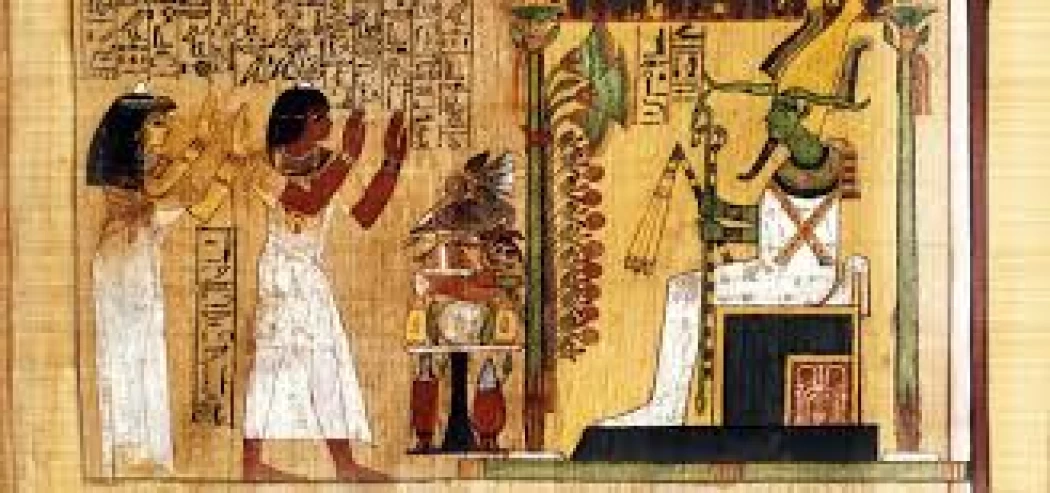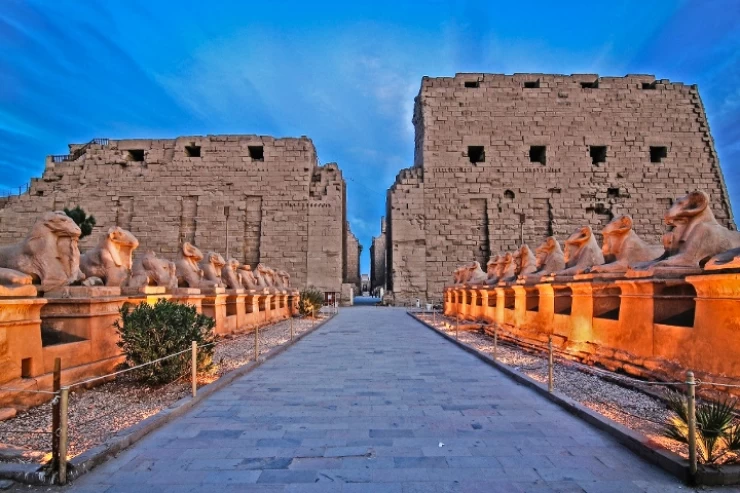
El libro de los muertos | Texto funerario egipcio antiguo
En su interior se encontraban textos funerarios de diversa índole, tanto fórmulas mágico-religiosas como relatos, con la ayuda de los cuales el difunto podía superar las innumerables pruebas a las que se enfrentaría en el largo y sinuoso camino que lo conducía a la presencia de Osiris. Los textos, por lo tanto, le habrían ayudado tanto a alcanzar al dios de la muerte sin ningún problema especial, como a preparar el llamado testimonio de su vida terrenal, cuya prueba pertenecía a Osiris.
El Libro de los Muertos ha tomado varias formas a lo largo del tiempo. Inicialmente, de hecho, las fórmulas y las historias se grababan en las paredes de la tumba, solo para grabarlas directamente en el sarcófago. Con el tiempo y hasta la dinastía XVIII (1543-1292 a.C.), el libro de los muertos volvió a cambiar de forma: los textos funerarios fueron trasladados al papiro, luego cerrados en un sarcófago junto con el difunto y todos aquellos objetos que pudieran ser útiles en su último viaje.
Estas fórmulas mágicas colocadas en tumbas, según las creencias, protegían y ayudaban a los difuntos en el inframundo, e incluyen himnos al dios Amón Ra, el dios del sol. Podemos ver descripciones de hechizos en los pasajes y paredes de las tumbas, en los envoltorios de las momias e incluso dentro de la máscara dorada del rey Tutankamón.
El Libro de los Muertos apareció por primera vez en el Imperio Nuevo, pero su texto evolucionó a partir de una larga historia de escritura funeraria mágica. Los más antiguos de ellos, los Textos de las Pirámides, eran accesibles solo para los egipcios. Luego evolucionaron a Textos de Ataúdes, una versión modificada de los Textos de las Pirámides, que se escribieron en ataúdes y se incluyeron en las tumbas de personas no reales, como egipcios ricos y representantes de la élite.
Osiris era el dios de la resurrección, y Ra era el dios del sol, una estrella en el Libro de los Muertos. Luego, 42 dioses adicionales se dirigen al juez. Aunque el texto en sí varía en contenido y orden, la historia suele dividirse en cuatro secciones principales: el difunto ingresa al inframundo y recupera los poderes físicos de los vivos, el difunto resucita y se une a Ra para levantarse como el sol todos los días, viaja por el cielo antes del juicio en el inframundo de los dioses y, finalmente, encuentra un alma.
Viaja a Egipto para visitar templos y pirámides egipcias y aprender más sobre la mitología y cientos de dioses adorados por los faraones, que eran muy similares a los humanos, amaban y odiaban, sentían celos, luchaban y morían durante un mito asombroso lleno de eventos alegres, activos y dramáticos que inspiró a cineastas y productores modernos a crear películas de fama mundial sobre la grandeza de los faraones y los dioses a los que adoraban. Reserve unos días para visitar Abidos, Giza, Luxor, Asuán para ver las tumbas de los faraones decoradas con escenas muy claras, detalladas y bellamente pintadas de varias deidades del Antiguo Egipto, así como muchos otros lugares, ciudades, aventuras y actividades en El Cairo, Puede intentar reservar uno de nuestros tours a Egipto y paquetes turísticos de Egipto muchos grupos privados con un guía Excursiones de un día a El Cairo desde el aeropuerto y excursiones de un día a Egipto para explorar la capital de Egipto, El Cairo Puede consultar muchos itinerarios de Egipto o realizar una de nuestras excursiones completas de un día a El Cairo, como:
- Rutas turísticas en Egipto / Rutas en Egipto |
- Tours a Asuán / Excursiones a Asuán | Excursiones de un día a Asuán / Visitas turísticas a Asuán.
Inside were funerary texts of various kinds, both magico-religious formulas and stories, with the help of which the deceased could overcome the countless trials that he would face on the long and winding path that led him to the presence of Osiris. The texts, therefore, would have helped him both to reach the god of death without any special problems, and to prepare the so-called testimony of his earthly life, the trial of which belonged to Osiris.
The Book of the Dead has taken various forms over time. Initially, indeed, formulas and stories were engraved on the walls of the tomb, only to be engraved directly on the sarcophagus. Over time and until the eighteenth dynasty (1543-1292 BC), the book of the dead changed its form again: the funeral texts were transferred to papyrus, then closed in a sarcophagus along with the deceased and all those objects that could be useful in his last journey.
These magical formulas placed in tombs, according to beliefs, protected and helped the deceased in the underworld, and they include hymns to the god Amun Re, the god of the sun. We can see descriptions of spells on the passages and walls of tombs, on the wrappers of mummies and even inside the golden mask of King Tutankhamun.
The Book of the Dead first appeared in the New Kingdom, but its text evolved from a long history of magical funeral writing. The most ancient of them, the Pyramid Texts, were accessible only to the Egyptians. Then they evolved to Coffin Texts - a modified version of the Pyramid Texts - which were written on coffins and included in the tombs of non-royal persons, such as rich Egyptians and representatives of the elite.
As for the history of the writing of the Book of the Dead, the Pharaohs wrote down the Book of the Dead during the era of the construction of the Great Pyramid, and a copy of it is still preserved in the British Museum. It contains invocations to the gods, hymns, and prayers. Then there is a description of the reckoning that the souls of the dead encounter in the afterlife and the punishment and reward that befalls them.
The Pharaohs built huge temples in addition to tombs that were no less magnificent and luxurious, as they believed in resurrection and the return of the soul, which they depicted in two close images, "Ka" or "Ba." They were also keen to place all the things related to the deceased, including food, jewelry, and everything he loved in his life, with him in his tomb, where the soul of the deceased could eat and drink from it when it returned to the body, and before seeking the afterlife.
The ancient Egyptians knew religious literature since the dawn of history, and their holy books varied, most of which were about death and the afterlife. Their books usually contained a group of religious texts that expressed the Egyptians' perception of the life of the dead in the afterlife, and included a group of spells that were recited when preparing the body for burial.
Perhaps the ancient Pharaohs amazed the world with the diversity of these texts, and their abundance of ancient religious spells and literature, which remained an icon no less important than the remaining monuments from the Pharaonic eras, such as temples, royal tombs, and obelisks. Among these books' most significant works are:
Book of the Dead
Pyramid texts
The Book of Two Paths
The Guide's Book
Spell No. 125 is one of the most famous texts of the Book of the Dead. Even those unfamiliar with the book, and those unfamiliar with Egyptian mythology, know about the spell without realizing it. It is the incantation describing the trial of the deceased's heart in the Hall of Justice by the god Osiris, and is one of the most famous known images from ancient Egypt, although the god with his scale is not actually described in the text. Given the importance of the deceased passing the test of his heart weight in order to pass into bliss, knowing what to say and how to act in the presence of Osiris, Thoth, Anubis and the forty-two judges was the most important information with which the deceased could reach the afterlife.
After death, Anubis guides the deceased to the Hall of Justice (also known as the Hall of Two Truths), where the deceased will make the Confession of Absolution (also known as the Declaration of Innocence). This Confession of Absolution was a list of forty-two sins that the individual could honestly deny never to commit. Once made, Osiris, Thoth, Anubis, and the Forty-Two Judges consulted.
If the confession was accepted, the deceased's heart was weighed in a balance against the white feather of Maat, the feather of truth. If the deceased's heart was lighter than the feather of Maat, their soul passed to Heaven; if it was heavier than the feather, the heart was thrown to the ground, where it was devoured by the divine monster Ammut, and its owner's soul ceased to exist.
Spell 125 begins with an introduction to the reader (i.e., the soul of the deceased): "What to say upon arrival at the Hall of Justice"















